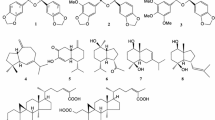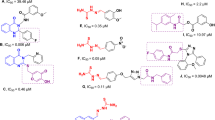Abstract
Anti-melanogenesis screening of 47 synthesized curcumin-like diarylpentanoid analogues was performed to show that some had a potent inhibitory effect on the melanogenesis in B16 melanoma cells. Their actions were considered to be mostly due to tyrosinase inhibition, tyrosinase expression inhibition, and melanin pigment degradation. The structure–activity relationships of those curcumin-like diarylpentanoid analogues which inhibited the melanogenesis and tyrosinase activity were also discussed. Of those compounds assayed, (2E,6E)-2,6-bis(2,5-dimethoxybenzylidene)cyclohexanone showed the most potent anti-melanogenesis effect, the mechanism of which is considered to be the degradation of the melanin pigment in B16 melanoma cells, affecting neither the tyrosinase activity nor tyrosinase expression.





Similar content being viewed by others
References
Yasui H, Sakurai H (2003) Age-dependent generation of reactive oxygen species in the skin of live hairless rats exposed to UVA light. Exp Dermatol 12:655–661
Kim YJ, Uyama H (2005) Tyrosinase inhibitors from natural and synthetic sources: structure, inhibition mechanism and perspective for the future. Cell Mol Life Sci 62:1707–1723
Hearing V, Jiménz M (1987) Mammalian tyrosinase. The critical regulatory control point in melanocyte pigmentation. Int J Biochem 19:1141–1147
Francois R, Luisa KA, Zalfa AAM, Vincent JH (2005) MC1R and the response of melanocytes to ultraviolet radiation. Mutat Res 571:133–152
Funasaka Y, Komoto M, Ichihashi M (2000) Depigmenting effect of α-tocopheryl ferulate on normal human melanocytes. Pigment Cell Res 13:170–174
Sturm RA, Teasdale RD, Box NF (2001) Human pigmentation genes: identification, structure and consequences of polymorphic variation. Gene 277:49–62
Srinivasan KR (1953) A chromatographic study of the curcuminoids in Curcuma longa L. J Pharm Pharmacol 5:448–457
Srimal RC, Dhawan BN (1973) Pharmacology of diferuloyl methane (curcumin), a non-steroidal anti-inflammatory agent. J Pharm Pharmacol 25:447–452
Chandru H, Sharada AC, Bettadaiah BK, Kumar CS, Rangappa KS, Sunila JK (2007) In vivo growth inhibitory and anti-angiogenic effects of synthetic novel dienone cyclopropoxy curcumin analogs on mouse Ehrlich ascites tumor. Bioorg Med Chem 15:7696–7703
Weber WM, Hunsaker LA, Abcouwer SF, Deck LM, Vander Jagt DL (2005) Anti-oxidant activities of curcumin and related enones. Bioorg Med Chem 13:3811–3820
Jordan WC, Drew CR (1996) Curcumin—a natural herb with anti-HIV activity. J Nat Med Assoc 88:333
Shirota S, Miyazaki K, Aiyama R, Ichioka M, Yokokura T (1994) Tyrosinase inhibitors from crude drugs. Biol Pharm Bull 17:266–269
Lee KH, Aziz FHA, Syahida A, Abas F, Shaari K, Israf DA, Lajis NH (2009) Synthesis and biological evaluation of curcumin-like diarylpentanoid analogues for anti-inflammatory, antioxidant and anti-tyrosinase activities. Eur J Med Chem 44:3195–3200
Beavo JA, Rogers NL, Crofford OB, Hardman JG, Sutherland EW, Newman EV (1970) Effects of xanthine derivatives on lipolysis and on adenosine 3′,5′-monophosphate phosphodiesterase activity. Mol Pharmacol 6:597–603
Chen JS, Wei CI, Marshall MR (1991) Inhibition mechanism of kojic acid on polyphenol oxidase. J Agric Food Chem 11:1897–1901
Kahn V (1995) Effect of kojic acid on the oxidation of DL-DOPA, norepinephrine, and dopamine by mushroom tyrosinase. Pigment Cell Res 8:234–240
Lerch K (1987) Monophenol monooxygenase from Neurospora crassa. Methods Enzymol 142:165–169
Matsuda H, Nakashima S, Oda Y, Nakamura S, Yoshikawa M (2009) Melanogenesis inhibitors from the rhizomes of Alpinia officinarum in B16 melanoma cells. Bioorg Med Chem 17:6048–6053
Tsuboi T, Kondoh H, Hiratsuka J, Mishima Y (1998) Enhanced melanogenesis induced by tyrosinase gene-transfer increases boron-uptake and killing effect of boron neutron capture therapy for amelanotic melanoma. Pigment Cell Res 11:275–282
Mosmann T (1983) Rapid colorimetric assay for cellular growth and survival: application to proliferation and cytotoxicity assays. J Immunol Methods 65:55–63
Acknowledgments
This work was supported by a Grant-in-Aid for Scientific Research from the Ministry of Education, Culture, Sports, Science, and Technology of Japan and a grant from The Open Research Center Project in Hoshi University. Authors also thank the Ministry of Science Technology and Innovation for the funds provided under the SAGA research funding program.
Author information
Authors and Affiliations
Corresponding author
Rights and permissions
About this article
Cite this article
Hosoya, T., Nakata, A., Yamasaki, F. et al. Curcumin-like diarylpentanoid analogues as melanogenesis inhibitors. J Nat Med 66, 166–176 (2012). https://doi.org/10.1007/s11418-011-0568-0
Received:
Accepted:
Published:
Issue Date:
DOI: https://doi.org/10.1007/s11418-011-0568-0




